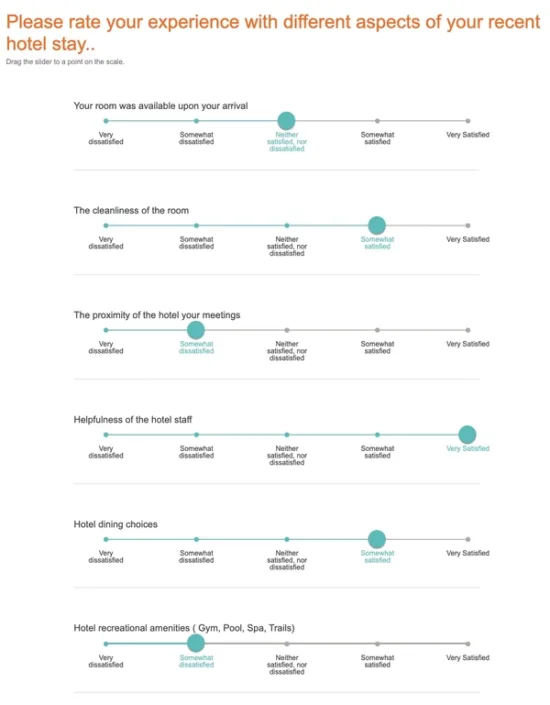Likert Scales in Market Research

Likert Scales make it easy to introduce precision measurement into your survey results
You might also like…
The Market Research Conference Circuit: Benefits & Challenges of a Crowded Calendar
There are many different market research conferences to pick and choose from in any given calendar month. What are the pros and cons of so many options?...
Why Qualitative Research is Essential in Market Research (and How EthOS Elevates It)
Discover why qualitative research is such an important part of market research and how OvationMR's tool EthOS can help. By: Anne Collins Date:...
Market research relies on capturing and understanding attributes for human attitudes and opinions to infer conclusions that facilitate critical decisions. Conventional, quantitative measurement techniques for data collection present a challenge in measuring the subjectivity of qualitative human behavior and perceptions.
Enter: psychometric techniques.
The very definition of the term implies the measurement of psychology. Various measurement instruments have been created, validated, and instituted to quantify human traits and transform them into objective realities.
Survey scales are one such category of psychometric measurement tools. These scales are attributed to elicit responses to qualitative or quantitative close-ended survey questions—these questions, in surveys using rating scales, present respondents with pre-populated options to choose from.
The Likert Scale Defined
A Likert scale is a type of rating scale often used for research in social sciences and education. It is one of the most widely used psychometric measurement tools to scale responses collected via questionnaires and surveys.
The eponymous scale was invented by an American social psychologist, Rensis Likert, in 1932 to measure his subjects’ opinions and attitudes on varied items. His creation took the form of a one-dimensional, 5 or 7-point-scale with bipolar agreement options. He wanted to capture people’s opinions in a way that he could then quantify and further analyze for patterns.
Since its invention and practice in the 1930s, the Likert scale has become one of the most commonly used rating scales. One of the main reasons behind its widely-accepted use is the fact that it offers more granular insight into human behavior, especially when compared to dichotomous, yes/no binary questions.
Examples of Likert Scale Item Types
Likert scale questions measure the respondents’ level of agreement/disagreement or satisfaction/dissatisfaction with particular statements. They do so on the assumption that the respondent’s attitude towards the question or statement is on a continuum from the positive pole to the negative.
While agreement measurements are most prevalent, Likert scales are also used to measure other variations of respondent attitudes such as likelihood, interest, frequency, importance, etc. Based on this, here are some examples of the Likert scale to give you a gist of what it looks like on questionnaires:
Agreement
- Strongly Agree
- Agree
- Neutral
- Disagree
- Strongly Disagree
Frequency
- Very Frequently
- Frequently
- Occasionally
- Rarely
- Never
Interest
- Very Interested
- Somewhat Interested
- Neutral
- Somewhat Uninterested
- Very Uninterested
Types of Likert Scale
Here, we are not discussing variations such as the Guttman or Bogardus scales, which evolved to measure very particular opinions. The types briefly discussed here are based on the composition of the scale itself.
Before we discuss the types, it’s important to clarify that the Likert scale in particular research is the sum of all responses in a questionnaire or survey. Each question or statement is considered a Likert Item, each paired with a visual analog scale (VAS).

Likert scale types are divided into two main categories – Odd and Even Likert scales.
Even Likert scales provide an even number of options on the scale. Typically, it is used in the form of a 4-point scale, where it contains two extreme options on each side of the bipolar scale without a neutral option in the middle. This type of Likert scale is also referred to as the forced-choice method as respondents have to choose between the negative or positive values.
Odd Likert scales, which are more commonly used, are bilaterally symmetrical and provide respondents with equal numbers of positive and negative options along with a neutral or zero value in the middle.
When to use a Likert scale
In market research, Likert scale surveys are used when researchers want to get more precise audience insights into what their audience thinks about a certain product or service. For example, market surveys studying the quality of a new phone and using a 7-point Likert scale may include a question like:
How satisfied are you with the sensitivity of the touch screen of the XY smartphone?
- Completely dissatisfied
- Mostly Dissatisfied
- Somewhat Dissatisfied
- Neither satisfied nor satisfied
- Somewhat Satisfied
- Mostly Satisfied
- Completely Satisfied
In some cases, the Likert item is also presented as a statement, eliciting a response on a scale measuring agreement:
I am satisfied with the sensitivity of the touch screen of the XY smartphone.
- Strongly Agree
- Somewhat Agree
- Neither Agree nor Disagree
- Somewhat Disagree
- Strongly Disagree
Likert Scale Data Analysis
When it comes to analyzing Likert scale data, there is some debate on whether the data itself should be considered interval-level or ordinal. There are different schools of thought, with the conflict rooted in whether the points on the Likert scale are equidistant and equivalent.
One of the key points in this debate arises from the fact that the scale is arbitrary. The values assigned to each point on the scale are determined by the researcher or surveyor who designed the questionnaire. Conventionally, these values are progressive, positive integers.
The main conflict arises when the topic of the distance between each successive point comes into question. We mean by this: is the distance between ‘strongly agree’ and ‘somewhat agree’ the same as the distance between ‘somewhat agree’ and ‘neutral’? Without equidistant categories, there is a chance of the results being biased in favor of a positive outcome.
A well-designed Likert scale boasts symmetry between categories, with clear qualifiers labeling each point. This leaves us with the question of whether Likert scale data should be considered as ordinal or interval-level.
Typically, when a balanced Likert scale is used with proper symmetry and balance, the data may act like interval-level data despite the scale being ordinal. Some researchers consider Likert scale data as interval data because they believe parametric tests are more accurate in determining and interpreting inferences.
In general, the intervals between points cannot be presumed as equal. As Likert scale data is ordinal in technicality, mean and standard deviation are not appropriate—instead, it summarizes data using median and mode as it is easier to interpret.
Strengths of the Likert Scale
As we’ve explained previously, Likert scales are readily used because they allow researchers to obtain more degrees of opinions, whether it’s negative, positive, or no opinion at all. It is much more explanatory than the binary results of yes/no answers.
Secondly, data obtained through the Likert Scale is easy to quantify, and hence, conducting statistical analysis based on those results is simpler.
Limitations when using Likert Scales
Certain factors may distort the results. Two of the most prevalent causes of skewed results are central tendency and social desirability biases. The latter influences the responses as the participants want to come off as more personable, which often leads to central tendency bias that compels respondents to choose the middle value on the Likert scale.
Depending on the type of research and the party conducting it, the respondents might want to portray themselves positively or negatively.
The solution to obviate these issues lies in designing the survey to have both positive and negative items. With a balanced Likert scale-based questionnaire, you can successfully manage and mitigate biases and obtain valuable insights that allow you to gauge feedback accurately.
Follow
OvationMR

Jim Whaley
Author
Jim Whaley is a business leader, market research expert, and writer. He posts frequently on The Standard Ovation and other industry blogs.
OvationMR is a global provider of first-party data for those seeking solutions that require information for informed business decisions.
OvationMR is a leader in delivering insights and reliable results across a variety of industry sectors around the globe consistently for market research professionals and management consultants.

Need help with your project?
We are ready to offer you:


